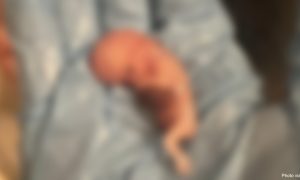A clinic worker interviewed by pro-abortion author Wendy Simonds wrote about how looking at the faces of late term aborted babies bothers her. Her clinic does abortions up to 26 weeks, the beginning of the third trimester. At 26 weeks, 80 to 90 percent of babies born premature can be expected to survive. These are babies who are just about ready to be born.
This clinic worker says she also feels ambivalence because she is adopted. Every time she sees an aborted baby, she knows her birth mother could have aborted her. She says:
There’s lots of days when it’s really, really hard…I don’t know what makes it so much harder at twenty-six weeks than at thirteen weeks. I don’t know what makes handling the tissue so much harder….For me, there’s a lot of probably some hidden guilt that I’m not willing to look at about my adoption. That could have been me.
You know, had my natural mother had access to abortion, this easily could have been me. And when you’re, you know, putting a fetus’s feet in over its head in a baggie, there’s just that brief moment of “this could have been me,” which I fundamentally believe is okay.
She should have had a right to choose that, and I, being a religious person, believe that things happen for a reason…It’s much more difficult when you see a twenty-six week face.

The face of a preborn baby at 24 weeks. Features would be even more individualized at 26 weeks
When disposing of the bodies of aborted children, this abortion facility worker thinks about how she may have narrowly escaped the same brutal fate as the dead babies she handles. These aborted children are dehumanized in the clinic, tossed into plastic baggies to be disposed of after being brutally killed. At least this abortion worker shows a glimmer of humanity as she handles their corpses.
It is eerie reading how the clinic worker rationalizes her abortion work. In claiming that her birth mother should have had the right to choose abortion, this facility worker is saying that her birth mother had a right to kill her. To avoid the uncomfortable implications of this statement, she hides behind a religious platitude, claiming “everything happens for a reason.”
Incidentally, late term abortions in this clinic were done by dismemberment abortion — the D&E abortion procedure, where the baby came out in pieces. In these abortions, the child is torn limb from limb with forceps These babies were butchered.

Perhaps at some point in the future, this clinic worker will come to realize that dismembering a baby is wrong, and that “everything happens for a reason” is not a good argument for abortion. Her cognitive dissonance may end and she may realize, like so many other former clinic workers, that abortion is wrong.
We can only hope.
Wendy Simonds Abortion at Work: Ideology and Practice in a Feminist Clinic (New Brunswick, NJ: Rutgers University Press 1996) 84







